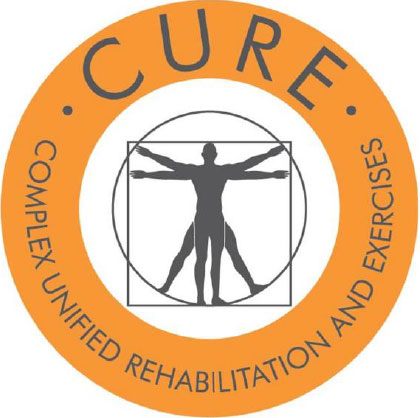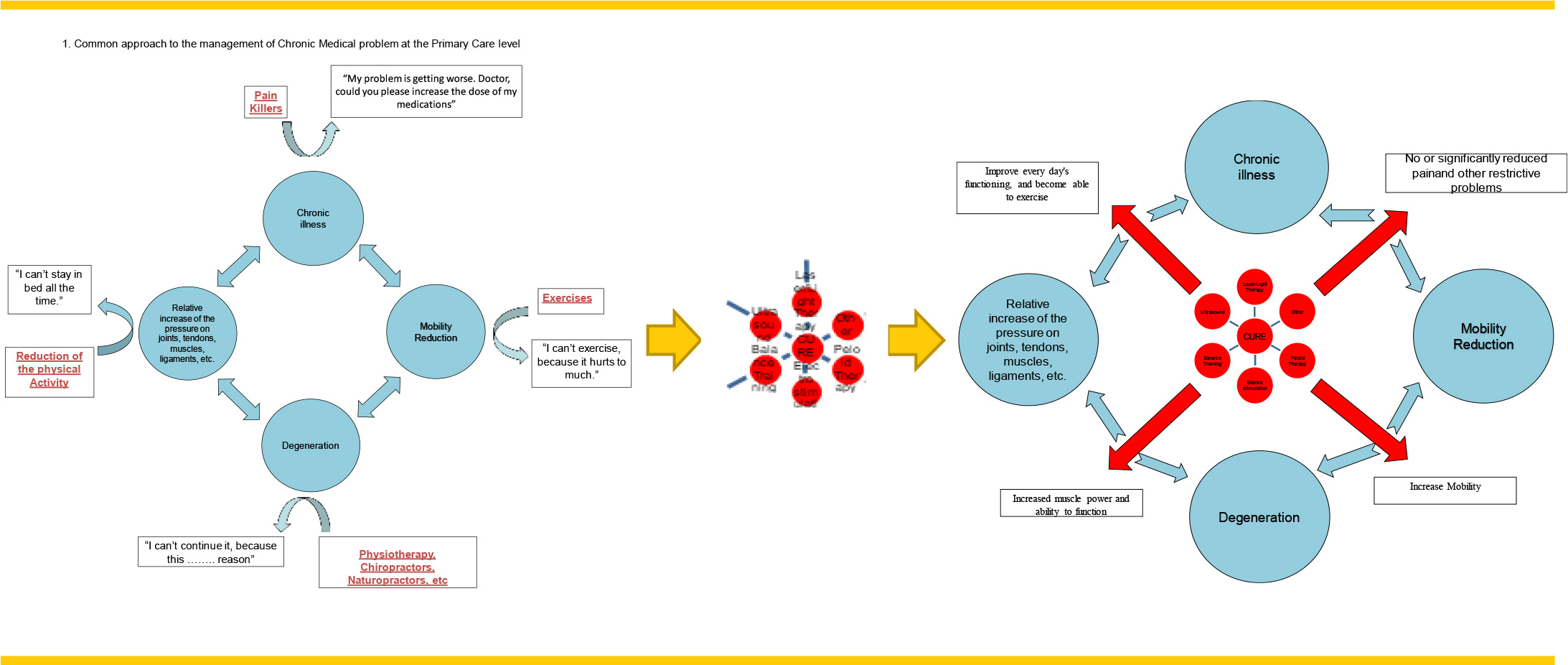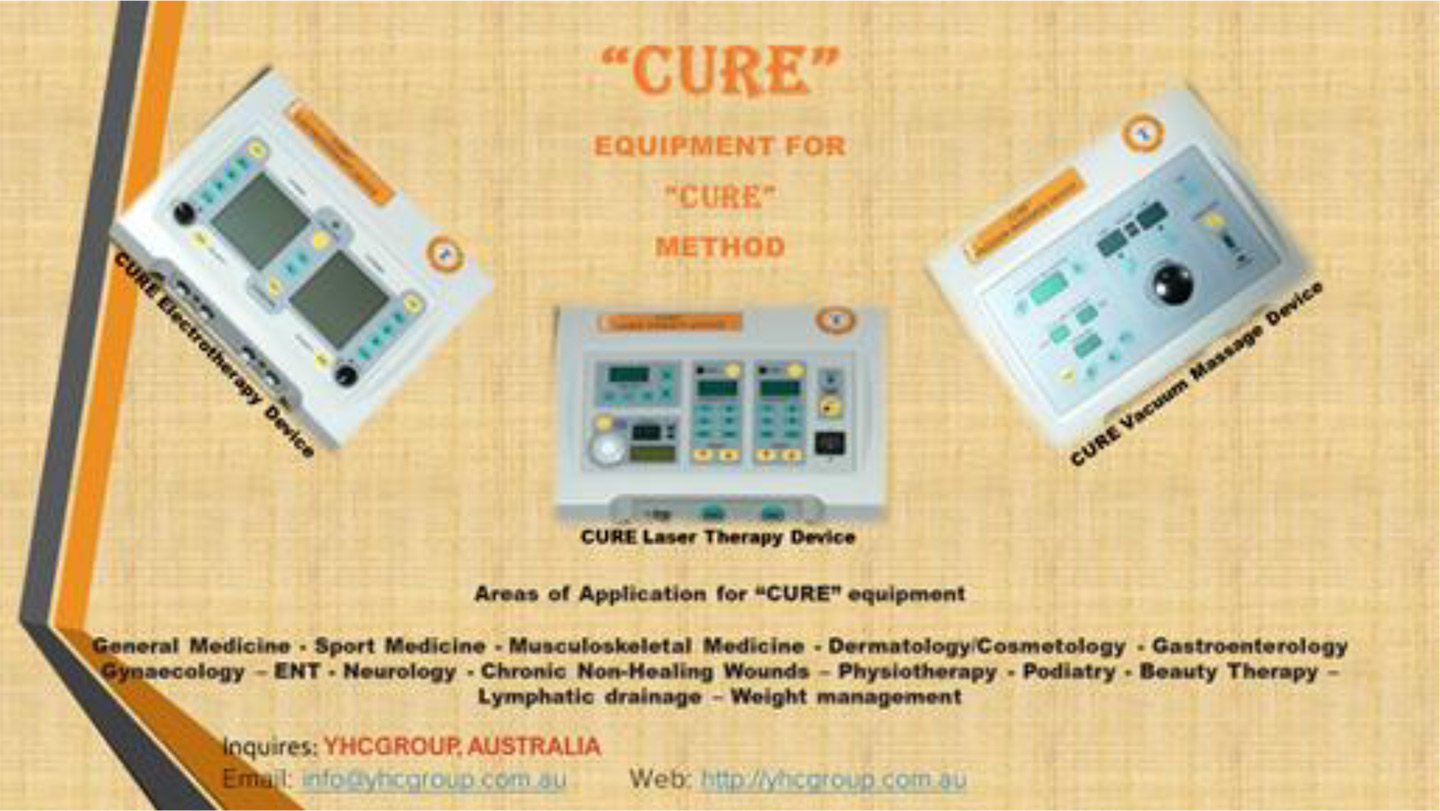
“The time for action is now. It's never too late to do something.”
Antoine de Saint-Exupery
"CURE"
INFORMATION LETTER
Project Founder: Dr. Serguei Kisselev
Editor: Svetlana Kisseleva
Objectives of the “Cure” method
- To promote research into, and knowledge of, the causes, mechanisms, diagnosis, treatment and other aspects of the “Cure” method.
- To provide a forum for the exchange of ideas related to the “Cure” method.
- To educate physicians, other health professionals and the general public about the “Cure” method
- To encourage the management of acute and chronic conditions to be conducted in a scientific and ethical manner.
- To promote, arrange and conduct meetings, seminars, conferences lectures, discussions and courses of study on the “Cure” method and related topics.
- Content:
- CURE method – introduction
- LED or LASER for LLLT?
- Case – severe shoulder injury rehabilitation
- GP Training and Recruitment
- “CURE” equipment for “CURE” method
The CURE method in the management and rehabilitation of patients with different chronic and acute medical problems in GP practice.
Today the increase in the ageing population is especially noticeable – GPs and other health professionals are facing the challenge of how to manage the problems associated with different acute and chronic medical conditions.
The biggest problem which we see these days is the prevalence of the sedentary lifestyle – 100m to the local shop – yet we use a car.
People are reluctant to conduct a reasonable level of physical activity for different social and medical reasons, especially among the older population.
Of course, education and physical activity are extremely important in the
management of cardiovascular, musculoskeletal, respiratory and other chronic problems. But how often do we see elderly people jogging or simply walking along a rural road or doing regular exercise in the gym? Next to none. The most common excuse doctors could hear are: “It hurts too much to exercise”, “I feel very uncomfortable exercising among healthy young people” or “I have enough physical activity gardening at home”. We have found it very challenging to engage elderly people suffering from different chronic conditions into regular exercising activities.
Orthopedic surgeons, Neurosurgeons and other specialists are not easily available in rural areas and the waiting list for a primary consultation could be as long as 4-6 months, or even longer for public patients.
Unfortunately, pharmaceutical management is not always the answer. Despite the wide range of modern medications, our patients often feel frustrated and unhappy due to their medication’s ineffectiveness.
Here we need to think about future management of chronic conditions, especially in association with increasing rate of physical inactivity and poor nutrition leading to overweight and obesity— combined with a growing and ageing population will lead to increasing numbers of people living with chronic diseases.
Aging population
Over the 20 years between 1999 and 2019, the proportion of the population aged 65 years and over increased from 12.3% to 15.9%. Tasmania – over (19.3%)
About half of all Australians have a chronic disease. The most common are:
- Musculoskeletal conditions – 1 in 4 (28%)
- Diabetes conditions – 1 in 19 (5.4%)
- Respiratory diseases (including asthma &COPD) – 1 in 10 (10%)
- Cardiovascular disease (CVD) – 1 in 5 Australians aged 18+ (22%)
Many of our patients have more than one condition
1 in 5 Australians (20%) affected by multiple chronic diseases
At Sheffield Medical Centre, we have developed a strategy to manage such conditions. The primary aim of this strategy is to improve and maintain the functional ability of people with different problems.
In our practice we use medical technologies which have been used for many years but were overshadowed by pharmaceutical methods. Unfortunately, methods such as Prolotherapy, PBM (LLLT), Electrostimulation, Peloid therapy, Rehabilitation exercises and similar are forgotten, ignored or even undeservedly dismissed despite their scientifically proven effectiveness and safety. Our strategy is to use these methods as a part of complex management.

Low fitness in elderly has equal size health effect as combination of
- Smoking,
- Diabetes and
- Obesity
Low fitness kills twice as many elderlies as smoking!
If we help people to make good lifestyle choices at all stages of their lives, we can help to keep them in good health and prevent exacerbation of illnesses for as long as possible.
Also, we like to share our experience and expertise with any health specialist who share our views. We are open to honest and constructive discussion. We are happy to put your cases or comments in this paper.
Dr. Serguei Kisselev
MBBS, FRACGP
Principal GP of the YHC (KRISS/ARH) Medical group
Founder of the C.U.R.E method,
Former President of the Australian Association of the Musculoskeletal Medicine. [email protected]
LED or LASER for Low Level Laser Therapy?
Original article by Sergey Vladimirovich Moskvin
Translator and Editor: Svetlana Kisseleva
This scientific article poses the question of lasers’ exclusivity, as well as the degree of influence of the special properties of low-intensity laser illumination (LILI), such as coherence, polarity and monochromaticity on the effectiveness of low-level laser therapy (LLLT) continues to cause arguments.
The study analyzes publications from 1973 to 2016, in which laser and conventional light sources are compared, and the following conclusions are drawn. Firstly, there are a lot of publications with incorrect comparisons or unfounded statements. Secondly, other sources of light are often referred to as LILI without any proof. Thirdly, all studies, in which the comparison is carried out correctly and close parameters of the impact and the model are used, have a firm conclusion that laser light is much more effective. Finally, it is clearly identified that the most important parameter that determines the efficiency of lasers is monochromaticity, i.e., a much narrower spectral width than for all other light sources.
Only laser light sources can be used for LLLT!
Contacts for full article:
Dr. Serguei Kisselev
Roman Kisselev
Manager of the Your Health Connect Group [email protected]
Or our website – https://yhcgroup.com.au/about/education/
Successful use of a combination of different methods in rehabilitation of a severe shoulder injury.
(CURE – complex unified Rehabilitation and exercises)
Dr. Serguei Kisselev
History:
P.M. – 70 y.o DVA male patient after MVA in December 2017 with complaints about moderate/severe right shoulder pain, which significantly affects their functional ability and sleep.
Examination:
- Rt shoulder ROM
- Forward flexion – 80 degree,
- Abduction – 60 degree
- Both internal and external rotations – very limited
Investigations:
- US of the right shoulder (Three weeks after the accident): High grade partial tear of supraspinatus tendon
- MRI of the right shoulder (three months after the accident):
- Large full thickness, almost complete tear of supraspinatus, with very early fatty replacement of the muscle belly. The remainder of the rotator cuff is intact.
- Gross subacromial/subdeltoid and subscapularis bursa effusion.
- Subacromial space stenosis related to AC joint arthrosis and marginal osteophytes.
- Secondary evidence of adhesive capsulitis.
Past Medical History: PTSD (Vietnam war veteran), IHD, HT, restless legs syndrome, OA, GORD
Current medications: Multivitamins, Norspan, Panadeine forte, Rosuvastatin, Amitriptiline, Arthro aid, Lyrica, Nexium, Olmesartan, Temaze, Venlafaxin.
Clinical progression:
- Straight after MVA: Not much pain, moderate restrictions of ROM. Gradually increasing pain in the Rt shoulder over one month, and he became significantly restricted in his ADL (activities of daily living) due to restrictions in Rt shoulder range of movements
- One month after the accident: Visited Local GP – referred for US Rt shoulder and then to Orthopaedic surgeon. Started Prolotherapy – had four sessions over the next two months, no significant improvement observed
- Three months after MVA – Appointment with Orthopaedic surgeon, following MRI and intraarticular corticosteroid injection. Prognosis: if the pain is managed, it could be possible to spontaneously resolve the stiffness in 12-18 months. Next three weeks – no clinical or functional improvement.
- Four months after MVA – Started combined therapy (CURE), which included:
- Prolotherapy – weekly (combination of classical and neural),
- Rehabilitation exercise program under supervision, three- four times a week.
- Low level Laser Therapy – course of 10 sessions daily
Result: Five months after MVA:
Full forward flexion, abduction and external rotation, mild/moderate restriction of internal rotation.
Functionally – returned to his almost unrestricted daily activity, no shoulder pain at night. Feels very happy about the achieved results. Patient rates his improvement as at least 80% of preinjury condition.
Continued rehabilitation exercises three-four times and prolotherapy once a week
Conclusion: The clinical application of the CURE method – Combined use of different methods aiming at both the stimulation of healing (Prolotherapy and LLLT) and the recovery of functional ability made the significant progression in rehabilitation of severe shoulder injury, which most likely would not be achievable in other circumstances.
Would you like to be a part of the CURE Method?
Your Health Connect Group offers short term contracts (6 months) to those candidates who are interested in learning advanced methods of treatment for Musculoskeletal Disorders (Certificate included). And the best part, you will be able to learn and work without losing the income!
Outside the short-term contracts, YHC group offers full-time positions to VR and Generally registered Australian Doctors. Please refer to the job description below.
Position Description:
Full or part time GPs are required to join clinics operated by Your Health Connect. The right candidates will require to deliver services focusing primarily on ageing population, including assessments, examinations, treatments, and case management. As well as proven methods, GPs will be expected to adopt and use contemporary technologies of rehabilitation and treatment. Great professional development is available, as well as in situ training provided by our leading specialists.
We offer the following:
- Accredited Training Practice
- Mixed Billing
- Supportive & Friendly Environment
- Rehabilitation facilities with gym, electrotherapy and laser therapy
- Full Time Nursing
- Onsite Pathology, Psychology, Physiotherapy, Podiatry, Dietician and Diabetes Educator
- Fully Accredited with AGPAL
- Fully Computerised
- Small, friendly and experienced team
- Secure onsite parking
- Your own consulting room
- Up to 70% of receipts is available based on experience and duties.
For more information refer to the following links:
Roman Kisselev
Manager of the Your Health Connect Group
Website: https://tasgpjobs.com.au/
Facebook: https://www.facebook.com/tasgpjobs/
Instagram: https://www.instagram.com/tasgpjobs/?hl=en

